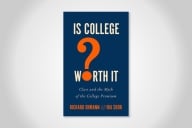You have /5 articles left.
Sign up for a free account or log in.
Literacy experts have for decades recognized that periodic hysteria over so-called literacy crises in the United States is based largely on myths. Nevertheless, the most recent crisis framed in the media names millennials’ overdependence on technology as somehow to blame, with texting especially suspect.
We can’t deny our SMS language (our “textese” or “txt-speak”) varies considerably from the sentences we write for work or school. Portmanteau words, ellipses, abbreviations, neologisms and emoticons aside, texts frequently carry what many academics would deem errors -- slips in punctuation and spelling that texters may overlook for the sake of quick communication. But while instructors may have by now wrapped their heads around the inevitability of texting and its role in evolving the English language, relatively few have acknowledged that texting is neither ruining English nor hindering individuals’ literacy or academic writing practices and abilities.
As we embarked upon a small-scale study of 10 multilingual undergraduate students’ everyday literacy practices at CUNY’s City College, we expected texting to come up as a regular practice of undergraduate students. What we had not anticipated was the range of valuable uses and substantive gains afforded by texting. We came to realize that we as educators are long overdue in exploring some of the advantages afforded by SMS language, although, of course, many of us already have. Texting, for instance, is proving to be a useful tool in higher education and for communicating in the classroom.
Preliminary results from our study, however, show that beyond offering opportunities to communicate quickly with friends, family, classmates and even teachers, texting also provides some intellectual benefits. Participants used texting to process feelings and ideas, and their texting practices seem to foster both an open-mindedness to language differences and a willingness to more actively negotiate communicative obstacles like unfamiliar language uses and errors.
A few examples from millennial texters themselves (whom we refer to throughout this article with pseudonyms) will help illustrate. When asked about her home literacy practices, Anne, 18, admits most of her daily reading and writing revolves around one mode: “I text. That’s all I do.” A freshman at City College, Anne sends texts to her friends and three sisters about her day, her observations on the commute to school and whatever pops into her head. There is often no response, but that is OK. She just wants to get her thoughts and intentions out there. Anne’s texting serves as her journal.
Contrary to perceptions that view virtual social interactions as inherently transient, Jessica, also 18, feels differently. “If I were to send a text, they [friends] would read and understand. But later on if they feel bad, they could look at it again, and be like, let me calm down again. It’s like reading writing later and having it to look back on. They are there with you,” she says. Jessica and her texter friends take advantage of texting as a written mode of communication to negotiate their gut responses to information with the more tempered interpretations that they come to with time and further reflection.
Nearly all students we interviewed expressed a preference for texting over speaking in person because, as Cindy, 25, puts it, “I can stop and think; how can I say this better, more correctly?” Text messages are not as spontaneous or heedless as we might assume. As an act, texting provides opportunities to process experiences, as well as communicate and maintain relationships. In addition, texting offers communicators regular practice with brainstorming, drafting, revising and editing. For instructors who emphasize treating writing as a process involving critical thinking and reflection, this is welcome news.
Nardin Sarkis, a student writer at the University of California, Santa Barbara, explains here that texting may call for increased attention to grammar and punctuation, not less: “When a simple period can mean the difference between an aggressive or inviting tone, more and more users will be punctuation conscious. This delicate focus on punctuation enriches communication and celebrates its intricacies.” Sarkis reminds us of the focus needed to switch effectively between registers and languages, as all speakers and writers do at one level or another.
Being multilingual calls for code-switching and, at times, a more hybridized language. Linguistic processes like these are becoming publicly known for enhancing cognition and social relations. And we can understand SMS language as one “code” to which writers switch. With this in mind, we instructors could be encouraging students to see value in texting and, yes, to enhance those communicative acts. The more students are cognizant of their own literacy practices, the more equipped they’ll be to build on their linguistic repertoires and the better they’ll be at navigating discursive expectations, including those of edited standardized English.
Of course, it is also the case that conventional spelling and punctuation errors are commonly overlooked in text messages and social media posts, a communicative norm that may not sit well with fellow teachers. But our participants help frame this practice as a benefit. Brooklynn, 18, explains that her texts to friends sometimes “… don’t even look like words … [but] random letters inserted into words where they shouldn’t be, with letters missing.” She attributes this brevity to typing too fast or to excitement. But, of interest, the errors do not matter all that much to her since people will get what she is trying to say.
Linguist and compositionist Suresh Canagarajah has emphasized the value of communicative approaches like Brooklynn’s in his discussion of strategies multilingual writers draw on when negotiating English in conversation and writing. One relative feature of multilingual communication, he explains, is that it is typically consensus oriented and supportive: “Multilinguals devise strategies to help each other achieve their interests by working with each other positively to achieve intelligibility.” This means that “if an interlocutor comes across an item that she feels is incorrect or unintelligible, she moves on with the conversation rather than attempting to correct, judge or walk away from the interaction.”
Texters like Brooklynn apply this conversational quality of open-minded negotiation of meaning to written communication. That is remarkable, at least in part because a movement toward more accommodating and concerted communication styles seems necessary to ensuring effective communication in increasingly diverse contexts, like that of our classrooms, the workplace, our neighborhoods and far beyond. Brooklynn’s perspectives on texting suggest there’s much hope for more widespread approaches to consensus-orientated communication.
Meaning and Openness
All that said, it is important to note here that Brooklynn’s openness to errors does not transfer into the formal classroom. Referring to participating in peer-review activities in her second-year composition course, Brooklynn admits to being a “mean person” about other students’ writing: “I’m like, this is wrong and this doesn’t make any sense and this is terrible … I had this long list of what was wrong with it.” Brooklynn is willing to negotiate and work through errors and omissions in texting contexts, and the norms guiding interactions over text and social media invite such a collaborative approach to receiving and interpreting communication. But her response to receiving information in an academic setting is one of dismissal and judgment.
As a reader in academic contexts, Brooklynn’s expectation is that the responsibility for effective communication lies solely on the shoulders of the author; thus, her willingness to work through communication, as an equal collaborator, disappears. Academic discourse offers its participants a variety of cognitive and rhetorical skills, but Brooklynn’s attitudinal shift from one context to the other reflects how expectations in academic discourse may foster closed-mindedness to language differences, nonstandardized communication practices and the presence of errors.
Of course, students should be aware of the values placed on “correctness” in academic discourse, and Brooklynn’s experience suggests that students are already privy to the demand for edited standardized English prose. But in this globalized era when students are bound to engage in intercultural communication, shouldn’t instructors and students alike be privileging making meaning over grammatical correctness? Openness over intolerance to difference? Collaborative negotiation of communication over idle reception of information? We say yes.
As educators, disavowing the red pen ourselves would be the first step toward teaching students to focus on meaning and accept differences. A second challenge lies in figuring out how to bring into our classrooms the openness our students already exercise in their everyday communication practices. We see promise in going beyond merely tolerating the inevitability of widespread texting. We should be celebrating the affordances of SMS language and treating texting as one of many ways to work with students to enhance their abilities to communicate effectively across different registers, languages and discourses.








